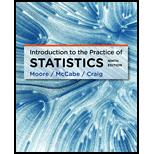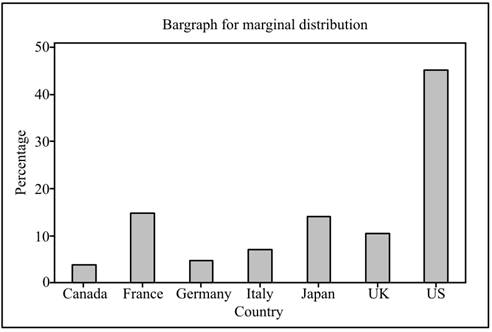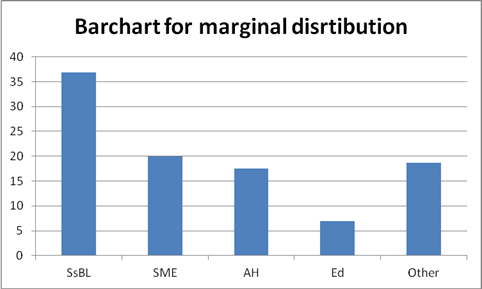
(a)
To find: The marginal total of the provided data to add them in the table.
(a)
Answer to Problem 153E
Solution: The obtained marginal totals are shown in the below table.
Field of study |
Canada |
France |
Germany |
Italy |
Japan |
UK |
US |
Total` |
SsBL |
64 |
153 |
66 |
125 |
250 |
152 |
878 |
1688 |
SME |
35 |
111 |
66 |
80 |
136 |
128 |
355 |
911 |
AH |
27 |
74 |
33 |
42 |
123 |
105 |
397 |
801 |
Ed |
20 |
45 |
18 |
16 |
39 |
14 |
167 |
319 |
Other |
30 |
289 |
35 |
58 |
97 |
76 |
272 |
857 |
Total |
176 |
672 |
218 |
321 |
645 |
475 |
2069 |
4576 |
Explanation of Solution
Calculation: To obtain the marginal totals, below steps are followed in the Minitab software.
Step 1: Enter the data in Minitab worksheet.
Step 2: Go to Stat > Tables >
Step 3: Select “Field” in “For rows” and select “Country” in “For columns”. And select “Count” in “Frequencies are in”.
Step 4: Select the option “Counts” under the “Categorical Variables”.
Step 5: Click OK twice.
The totals are obtained as the Minitab output. The obtained marginal totals are shown in the below table.
Field of study |
Canada |
France |
Germany |
Italy |
Japan |
UK |
US |
Total |
SsBL |
64 |
153 |
66 |
125 |
250 |
152 |
878 |
1688 |
SME |
35 |
111 |
66 |
80 |
136 |
128 |
355 |
911 |
AH |
27 |
74 |
33 |
42 |
123 |
105 |
397 |
801 |
Ed |
20 |
45 |
18 |
16 |
39 |
14 |
167 |
319 |
Other |
30 |
289 |
35 |
58 |
97 |
76 |
272 |
857 |
Total |
176 |
672 |
218 |
321 |
645 |
475 |
2069 |
4576 |
Interpretation: The row Total of the table indicates the marginal total corresponding to the Field of Study and the column Total shows the marginal totals for each country.
(b)
To find: The marginal distribution for the countries of the provided data and the graphical representation of the distribution.
(b)
Answer to Problem 153E
Solution: The obtained marginal totals are shown in the below table.
Country |
Canada |
France |
Germany |
Italy |
Japan |
UK |
US |
Total |
Marginal Percentage |
3.846 |
14.685 |
4.764 |
7.015 |
14.095 |
10.38 |
45.214 |
100 |
And the graphical representation is shown below:

Explanation of Solution
Calculation: To obtain the marginal distribution, below steps are followed in the Minitab software.
Step 1: Enter the data in Minitab worksheet.
Step 2: Go to Stat > Tables > Descriptive Statistics.
Step 3: Select “Field” in “For rows” and select “Country” in “For columns”. And select “Count” in “Frequencies are in”.
Step 4: Select the option “Total percents” and under the “Categorical Variables”.
Step 5: Click OK twice.
The percentage of totals are obtained as the Minitab output. The obtained marginal distribution are shown in the below table.
Country |
Canada |
France |
Germany |
Italy |
Japan |
UK |
US |
Total |
Marginal Percentage |
3.846 |
14.685 |
4.764 |
7.015 |
14.095 |
10.38 |
45.214 |
100 |
Graph: The marginal distribution is graphically shown by using the bar graph. To obtained the graphical representation, below steps are followed in the Minitab software.
Step 1: Insert the data into the worksheet.
Step 2: Go to Graph
Step 3: Click on the drop down menu of “Bar represents” and select “Values from table”.
Step 3: Select “Simple” and click “OK”.
Step 4: Specify the “Graph variables” and “Categorical variable”.
Step 5: Click “OK”.
The bar graph is obtained as:

Interpretation: The maximum percentage of students belongs to US whereas the minimum percentage of the students belongs to Canada.
(c)
To find: The marginal distribution for the Field of study of the provided data and the graphical representation of the distribution.
(c)
Answer to Problem 153E
Solution: The obtained marginal totals are shown in the below table.
Field of study |
SsBL |
SME |
AH |
Ed |
Other |
Total |
Marginal Percentage |
36.888 |
19.908 |
17.504 |
6.971 |
18.728 |
100 |
And the graphical representation is shown below:

Explanation of Solution
Calculation: To obtained the marginal totals, below steps are followed in the Minitab software.
Step 1: Enter the data in Minitab worksheet.
Step 2: Go to Stat > Tables > Descriptive Statistics.
Step 3: Select “Field” in “For rows” and select “Country” in “For columns”. And select “Count” in “Frequencies are in”.
Step 4: Select the option “Total percents” and under the “Categorical Variables”.
Step 5: Click OK twice.
The percentage of totals are obtained as the Minitab output. The obtained marginal distribution are shown in the below table.
Field of study |
SsBL |
SME |
AH |
Ed |
Other |
Total |
Marginal Percentage |
17.504 |
6.971 |
18.728 |
19.908 |
36.888 |
100 |
Graph: The marginal distribution is graphically shown by using the bar graph. To obtain the graphical representation, below steps are followed in the Minitab software.
Step 1: Insert the data into the worksheet.
Step 2: Go to Graph
Step 3: Click on the drop down menu of “Bar represents” and select “Values from table”.
Step 3: Select “Simple” and click “OK”.
Step 4: Specify the “Graph variables” and “Categorical variable”.
Step 5: Click “OK”.
The bar graph is obtained as:

Interpretation: The maximum percentage of students studies SsBL fields whereas the minimum percentage of the students studies Ed.
Want to see more full solutions like this?
Chapter 2 Solutions
Introduction to the Practice of Statistics
 MATLAB: An Introduction with ApplicationsStatisticsISBN:9781119256830Author:Amos GilatPublisher:John Wiley & Sons Inc
MATLAB: An Introduction with ApplicationsStatisticsISBN:9781119256830Author:Amos GilatPublisher:John Wiley & Sons Inc Probability and Statistics for Engineering and th...StatisticsISBN:9781305251809Author:Jay L. DevorePublisher:Cengage Learning
Probability and Statistics for Engineering and th...StatisticsISBN:9781305251809Author:Jay L. DevorePublisher:Cengage Learning Statistics for The Behavioral Sciences (MindTap C...StatisticsISBN:9781305504912Author:Frederick J Gravetter, Larry B. WallnauPublisher:Cengage Learning
Statistics for The Behavioral Sciences (MindTap C...StatisticsISBN:9781305504912Author:Frederick J Gravetter, Larry B. WallnauPublisher:Cengage Learning Elementary Statistics: Picturing the World (7th E...StatisticsISBN:9780134683416Author:Ron Larson, Betsy FarberPublisher:PEARSON
Elementary Statistics: Picturing the World (7th E...StatisticsISBN:9780134683416Author:Ron Larson, Betsy FarberPublisher:PEARSON The Basic Practice of StatisticsStatisticsISBN:9781319042578Author:David S. Moore, William I. Notz, Michael A. FlignerPublisher:W. H. Freeman
The Basic Practice of StatisticsStatisticsISBN:9781319042578Author:David S. Moore, William I. Notz, Michael A. FlignerPublisher:W. H. Freeman Introduction to the Practice of StatisticsStatisticsISBN:9781319013387Author:David S. Moore, George P. McCabe, Bruce A. CraigPublisher:W. H. Freeman
Introduction to the Practice of StatisticsStatisticsISBN:9781319013387Author:David S. Moore, George P. McCabe, Bruce A. CraigPublisher:W. H. Freeman





